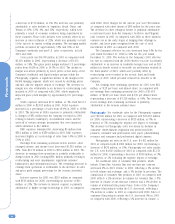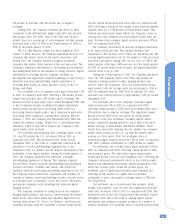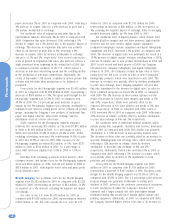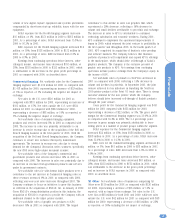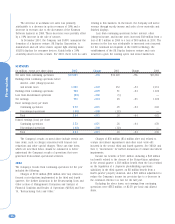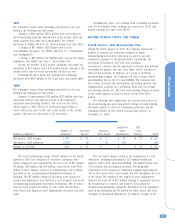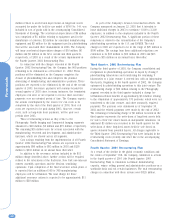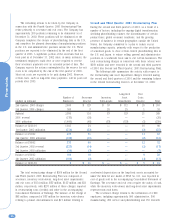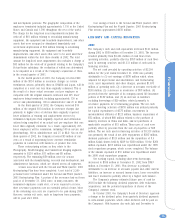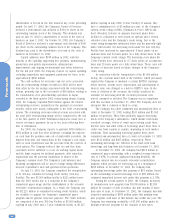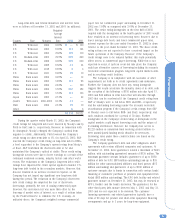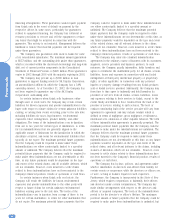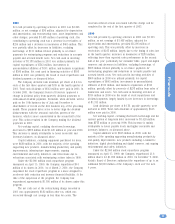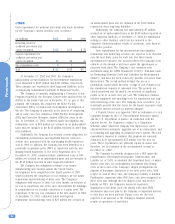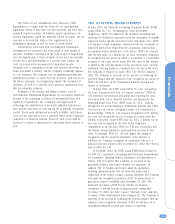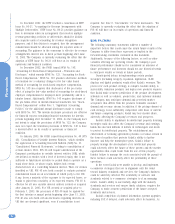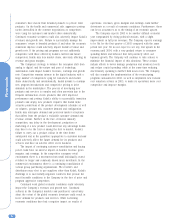Kodak 2002 Annual Report Download - page 26
Download and view the complete annual report
Please find page 26 of the 2002 Kodak annual report below. You can navigate through the pages in the report by either clicking on the pages listed below, or by using the keyword search tool below to find specific information within the annual report.
Financials
26
shareholders of record on the first business day of the preceding
month. On April 11, 2002, the Company’s Board of Directors
declared a semi-annual cash dividend of $.90 per share on the
outstanding common stock of the Company. This dividend was
paid on July 16, 2002 to shareholders of record at the close of
business on June 3, 2002. On October 10, 2002, the Company’s
Board of Director’s declared a semi-annual cash dividend of $.90
per share on the outstanding common stock of the Company. This
dividend was paid to the shareholders of record at the close of
business on December 13, 2002.
Capital additions were $577 million in 2002, with the
majority of the spending supporting new products, manufacturing
productivity and quality improvements, infrastructure
improvements and ongoing environmental and safety initiatives.
For the full year 2003, the Company expects its capital spending,
excluding acquisitions and equipment purchased for lease, to be
approximately $600 million.
The cash outflows for severance and exit costs associated
with the restructuring charges recorded in 2002 will be more
than offset by the tax savings associated with the restructuring
actions, primarily due to the tax benefit of $46 million relating to
the consolidation of its photofinishing operations in Japan
recorded in the third quarter 2002 restructuring charge. During
2002, the Company expended $220 million against the related
restructuring reserves, primarily for the payment of severance
benefits, which were mostly attributable to the 2001 restructuring
actions. The remaining severance-related actions associated with
the total 2001 restructuring charge will be completed by the end
of the first quarter of 2003. Terminated employees could elect to
receive severance payments for up to two years following their
date of termination.
For 2003, the Company expects to generate $450 million to
$650 million in cash flow after dividends, excluding the impacts
on cash from the purchase and sale of marketable securities, the
impacts from debt and transactions in the Company’s own equity,
such as stock repurchases and the proceeds from the exercise of
stock options. The Company believes that its cash flow from
operations will be sufficient to cover its working capital needs
and the funds required for dividend payments, debt reduction,
acquisitions and the potential repurchase of shares of the
Company’s common stock. The Company’s cash balances and
financing arrangements will be used to bridge timing differences
between expenditures and cash generated from operations.
On July 12, 2002, the Company completed the renegotiation
of its 364-day committed revolving credit facility (364-Day
Facility). The new $1,000 million facility is $225 million lower
than the 2001 facility due to a reduction in the Company’s
commercial paper usage and the establishment of the accounts
receivable securitization program. As a result, the Company now
has $2,225 million in committed revolving credit facilities, which
are available to support the Company’s commercial paper
program and for general corporate purposes. The credit facilities
are comprised of the new 364-Day Facility at $1,000 million
expiring in July 2003 and a 5-year committed facility at $1,225
million expiring in July 2006 (5-Year Facility). If unused, they
have a commitment fee of $3 million per year, at the Company’s
current credit rating of BBB+ (Standard & Poor’s (S&P)) and
Baa1 (Moody’s). Interest on amounts borrowed under these
facilities is calculated at rates based on spreads above certain
reference rates and the Company’s credit rating. Due to the
credit rating downgrades mentioned below and the generally tight
bank credit market, the borrowing costs under the new 364-Day
Facility have increased by approximately 7 basis points on an
undrawn basis and 40 basis points on a fully drawn basis at the
Company’s current credit ratings. The borrowing costs under the
5-Year Facility have increased by 6.5 basis points on an undrawn
basis and 20 basis points on a fully drawn basis. These costs will
increase or decrease based on future changes in the Company’s
credit rating.
In connection with the renegotiation of the $1,000 million
facility, the covenant under both of the facilities, which previously
required the Company to maintain a certain EBITDA (earnings
before interest, income taxes, depreciation and amortization) to
interest ratio, was changed to a debt to EBITDA ratio. In the
event of violation of the covenant, the facility would not be
available for borrowing until the covenant provisions were
waived, amended or satisfied. The Company was in compliance
with this covenant at December 31, 2002. The Company does not
anticipate that a violation is likely to occur.
The Company has other committed and uncommitted lines of
credit at December 31, 2002 totaling $241 million and $1,993
million, respectively. These lines primarily support borrowing
needs of the Company’s subsidiaries, which include term loans,
overdraft coverage, letters of credit and revolving credit lines.
Interest rates and other terms of borrowing under these lines of
credit vary from country to country, depending on local market
conditions. Total outstanding borrowing against these other
committed and uncommitted lines of credit at December 31, 2002
were $143 million and $465 million, respectively. These
outstanding borrowings are reflected in the short-term bank
borrowings and long-term debt balances at December 31, 2002.
At December 31, 2002, the Company had $837 million in
commercial paper outstanding, with a weighted average interest
rate of 1.97%. To provide additional financing flexibility, the
Company entered into an accounts receivable securitization
program, which provides for borrowings up to a maximum of
$400 million. At December 31, 2002, the Company had
outstanding borrowings under this program of $74 million. Based
on the outstanding secured borrowings level of $74 million, the
estimated annualized interest rate under this program is 2.13%.
During the second quarter of 2001, the Company increased
its medium-term note program from $1,000 million to $2,200
million for issuance of debt securities due nine months or more
from date of issue. At December 31, 2002, the Company had debt
securities outstanding of $700 million under this medium-term
note program, with none of this balance due within one year. The
Company has remaining availability of $1,200 million under its
medium-term note program for the issuance of new notes.


